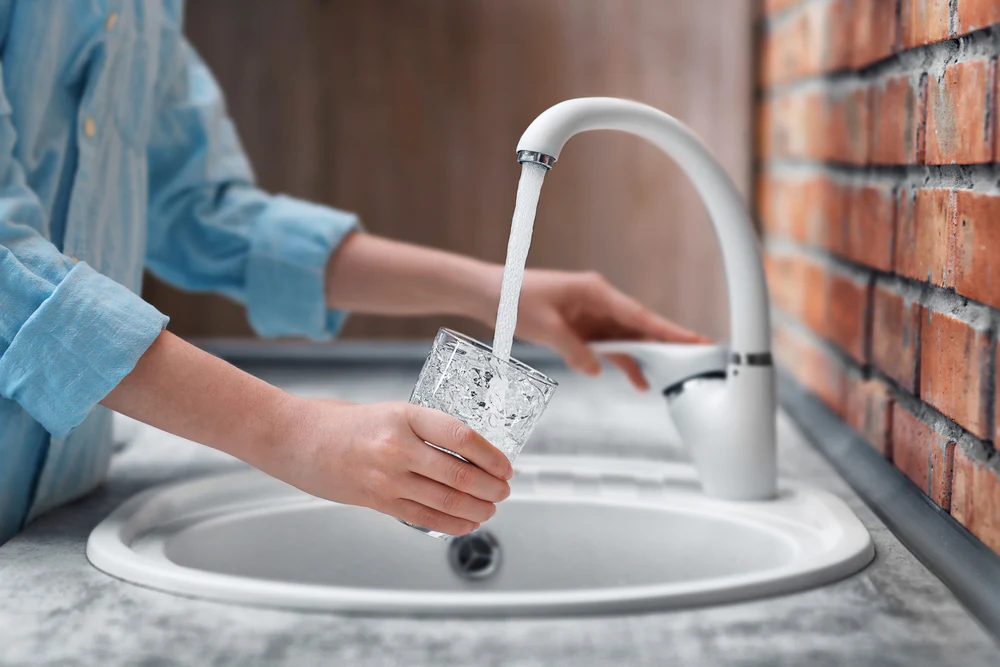There’s a lot of information available regarding lead contamination in water. It’s important to decipher what’s factual versus what’s perceived as truth. The more you understand the myths about lead in drinking water, the better you’ll be able to limit your risk of contamination or lead poisoning.
Furthermore, knowing ways to reduce lead exposure and how to remove lead from water is paramount to the health of your guests and employees. Here are a few of the common myths circulating today, in addition to how you can get healthy, delicious and safe drinking water by transforming what’s available from the tap.
#1: Boiling Water Removes Lead
The Centers for Disease Control and Prevention (CDC) and U.S. Environmental Protection Agency (EPA) have discussed the effects of water temperature with regards to protection from various contaminants. The EPA confirms boiling water does not remove lead from water.1 In fact, health experts say hot water actually releases more lead in pipes than cold water, so it’s better to allow your tap to run for several minutes when that faucet is switched to cold.2
This myth most likely stemmed from information about hot water killing germs and bacteria. The CDC has said boiling water is the go-to method to kill disease-causing organisms, including bacteria, viruses, and parasites when a fresh water supply is unavailable.3 However, boiling water is not only ineffective in removing lead, it’s also not a sustainable way to purify water that’s been contaminated by other pollutants.
#2: All Water Filters Remove Lead
Some methods and water treatment techniques are effective in removing certain pollutants but not all that may be present in your tap water. Each type of filtration provides its own benefits. There’s not a single water filter that can remove every type of contaminant, which is why a multi-stage filtration system is the best option to get the most purified water. For the removal of lead, specifically, the CDC recommends using reverse osmosis.
Water systems that use reverse osmosis allow water to pass through a semi-permeable membrane with a pore size of approximately 0.0001 micron. This process is highly effective in removing chemical contaminants, including lead, chromium, and copper.4 It also has a high effective rate in removing viruses, bacteria, and protozoa.
FloWater’s advanced osmosis filtration system sets a new standard in the purification process. It is five times more efficient than reverse osmosis systems or anything else available on the market. It’s the third filter in the lineup of an advanced, seven-step system and removes heavy metals, dissolved solids, pharmaceuticals, and pesticides, among the list of contaminants often found in tap water.
#3: Lead in Drinking Water Is Only Found in Older Homes
Both older homes and buildings have a greater probability of elevated lead levels. Lead service lines have been part of city infrastructures for centuries. As recently as 2014, plumbing fixtures could have as much as eight percent lead-by-weight and still be legally labeled lead-free.5 Although a building may not have lead pipes, soldering and other plumbing materials may be made of or contain a percentage of lead.
Therefore, lead contamination in water is a potential problem for any dwelling or building that’s attached to a city’s main water supply. This includes schools, daycares, restaurants, and other public arenas where people use tap water from faucets or water fountains as their central water supply. Since lead accumulates in the body over time, minimal exposure from various places can lead to harmful health effects, particularly in infants and women who are pregnant, regardless of how much lead is in their own home.
#4: Lead in the Water Supply Only Affects a Certain Part of the U.S.
There has been national media attention regarding the water crisis in various parts of the country. However, lead in public water supplies is more common than what’s routinely reported. Flint, Michigan received the most coverage in recent times due to the high level of contamination of their local drinking water.
Meanwhile, The Washington Post reported 274 water utilities serving over 11 million consumers exceeded the EPA’s lead concentration standard over several years. This list included major cities, such as Boston, Philadelphia, and New York.6 These numbers reflect a sampling of the number of municipalities that have outdated water systems, problems with corrosion control, and a lack of action items in place to fix these problems. There are a variety of factors that affect a city’s water supply and lead contamination can and does happen everywhere.
#5: If the City Provides a Water Report, the Water Is Clean
A city’s water report isn’t sent to say the water is clean. It’s sent to share information about the quality of the water supply. As has been revealed over the years, a city water report doesn’t share the whole picture of the water quality of the public water system. With this knowledge, it’s important to know how to test for lead in your drinking water.
Each community water supplier is required by the EPA to provide a Consumer Confidence Report (CCR) on an annual basis. It outlines the most recent information about the city’s water quality. The purpose of the CCR is to make contaminant levels and violations public knowledge. It also highlights how the violations can affect human health and what actions, if any, are being taken to correct the problem. This transparency can result in a sense of false confidence in the quality of water.
Findings can change from year to year, due to changing events, such as pollution to water sources and the type of chemicals and metals used in plumbing fixtures and materials. Keep in mind, the EPA has set a maximum contaminant level of lead in water at zero, which means anything higher than that is in violation. This is due to the high toxicity of lead even at low exposure levels. To be safe, it’s a great idea to drink filtered water with a water dispenser for home.
#6: Lead in Drinking Water Isn’t a Problem Since the Lead and Copper Rule Was Introduced
For centuries, lead and copper were the main plumbing materials used in city water systems. Over time, it was revealed that exposure to these elements led to a range of health problems, especially among babies, children, and pregnant women. In 1991, the EPA set forth a regulation to help control the level of copper and lead contamination in water.
It required systems to monitor drinking water so lead did not exceed an action level of 15 ppb and copper did not exceed an action level of 1.3 ppm in more than 10 percent of sampled customer taps.7 With the high number of reported cases that have occurred since then, it’s safe to say that despite this regulation, lead in drinking water is still a problem.
There wasn’t a major update to the Lead and Copper Rule for nearly three decades until recently. In December 2020, the EPA released new public water system requirements, which include:
- Setting a plan to replace water lines as soon as water sample results are above the trigger or action level set.
- Public water systems cannot avoid replacing lead service lines through testing.
- Public water systems are required to replace the water system-own portion of a lead service line when a customer chooses to replace their customer-owned portion of the line.8
The updates to the Lead and Copper Rule are designed to strengthen regulations for the safety of communities but do not automatically make all public drinking water safe and issues of urban water pollution still remain.
#7: Bottled Water Is the Safest Way to Avoid Lead-Contaminated Water
For years, people relied on bottled water as the answer to avoid drinking tap water that may be contaminated with lead and other pollutants. Although, it’s been reported in recent years that nearly half of all commercially-packaged bottled water is actually sourced from tap water, often without any further filtration in place.9 In addition to possibly having the same level of lead contamination as public drinking water, the expense and damaging effect on the environment from plastic waste has caused many to start using water purification technology instead.
The FloWater Refill Station transforms tap water by filtering it through seven stages to purify and improve upon it. Each filtering stage of the FloWater Refill Station is designed to remove specific contaminants from the water source and add back healthy minerals and electrolytes. The result is the best-tasting, most purified water available without the need for plastic use.
Removing Lead from Tap Water Through FloWater’s Refill Station
In addition to reverse osmosis and distillation, the CDC recommends the use of active carbon filters as an effective way to remove lead in drinking water.4 Prior to the advanced osmosis filter, which is responsible for removing lead, a carbon filter is applied as the second step of the Refill Station’s purification process. It captures smaller particles, including heavy metals, hydrogen sulfide, and chlorine, and removes lingering odors and unpleasant tastes from tap water.
The CDC also reports that water with high acidity or low mineral content corrodes water pipes and household plumbing fixtures, which increases the amount of lead in tap water.1 To neutralize water acidity, the alkaline enhancement adds ten trace minerals, which helps alleviate stress on the internal organs that work hard to rid acid from the body.
The FloWater Refill station is designed with filters designed specifically to remove and neutralize the effects of lead, and each step adds to the high quality of water, which includes delivering a crisp, clean finish. Furthermore, the Refill Station provides a touchless water purification solution that has fast auto-replenishment to support a high capacity of people.
Plus, it’s clean and self-sanitizing to make the experience even better for customers and visitors. People want lead-free, safe-to-drink, great-tasting water that’s readily available everywhere. This advanced technology and accessibility makes sense for the convenience of the modern world.
Sources:
1 ) “Basic Information about Lead in Drinking Water.” EPA, Environmental Protection Agency, 9 Dec. 2020, www.epa.gov/ground-water-and-drinking-water/basic-information-about-lead-drinking-water.
2) Let It Run…and Get the Lead out! Fact Sheet – EH: Minnesota Department of Health, www.health.state.mn.us/communities/environment/water/factsheet/letitrun_english.html.
3) “Making Water Safe in an Emergency.” Centers for Disease Control and Prevention, Centers for Disease Control and Prevention, 23 Feb. 2021, www.cdc.gov/healthywater/emergency/making-water-safe.html.
4) “Technical Information on Home Water Treatment Technologies.” Centers for Disease Control and Prevention, Centers for Disease Control and Prevention, 4 Aug. 2020, www.cdc.gov/healthywater/drinking/home-water-treatment/household_water_treatment.html.
5) “Lead in U.S. Drinking Water.” SciLine, 5 Mar. 2021, www.sciline.org/water-quality/drinking-lead/.
6) Lambrinidou, Yanna, and Marc Edwards. “Five Myths about Lead in Water.” The Washington Post, WP Company, 26 Feb. 2016, www.washingtonpost.com/opinions/five-myths-about-lead-in-water/2016/02/26/a3279d26-d686-11e5-9823-02b905009f99_story.html.
7) “Lead and Copper Rule.” EPA, Environmental Protection Agency, 10 Feb. 2021, www.epa.gov/dwreginfo/lead-and-copper-rule.
8) The New Lead and Copper Rule – US EPA. www.epa.gov/sites/production/files/2020-12/documents/lcr_overview_fact_sheet_12-21-2020_final.pdf.
9) Brodwin, Erin. “12 Facts That Show Why Bottled Water Is One of the Biggest Scams of the Century.” Business Insider, Business Insider, 20 Mar. 2019, www.businessinsider.com/bottled-water-facts-science-healthy-2017-4.





